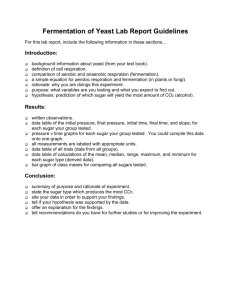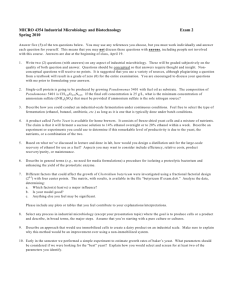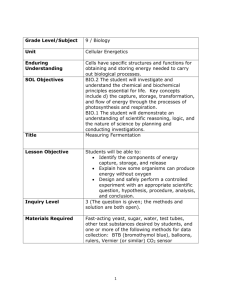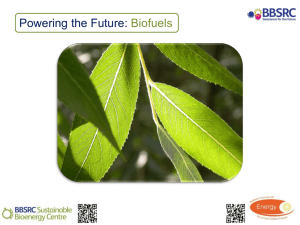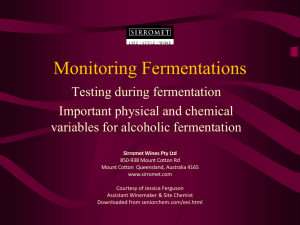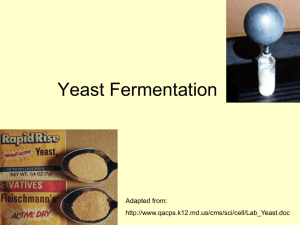Fermentation Variables ppt
advertisement
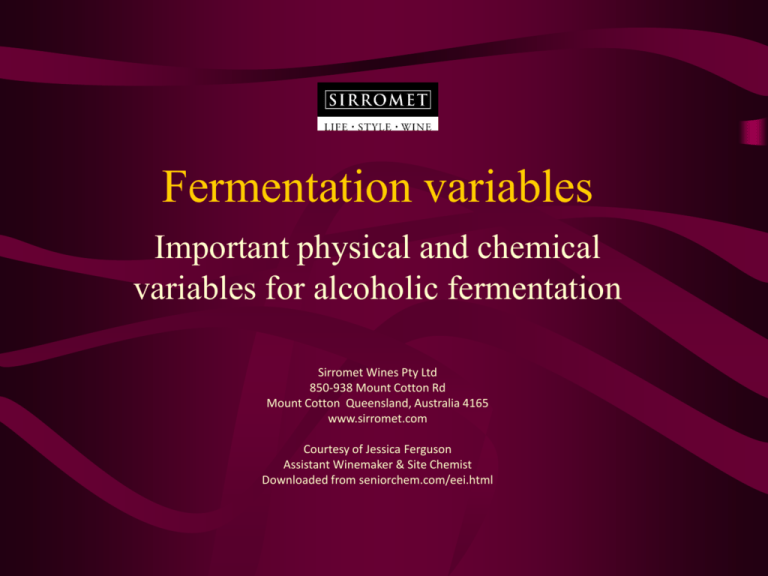
Fermentation variables Important physical and chemical variables for alcoholic fermentation Sirromet Wines Pty Ltd 850-938 Mount Cotton Rd Mount Cotton Queensland, Australia 4165 www.sirromet.com Courtesy of Jessica Ferguson Assistant Winemaker & Site Chemist Downloaded from seniorchem.com/eei.html A cautionary note… • Remember that a hydrometer does not measure ‘sugar’ or for that matter, ‘alcohol’, directly • A hydrometer measures density • Any component in solution that affects solution density will affect S.G. • Sugar increases density, alcohol decreases density • You cannot calculate either sugar content or alcohol content from an S.G. reading where both sugar and alcohol are present! ‘Investigations’ in Fermentation • A common assignment seems to be to investigate the effects of changing one variable in the must/juice • Important to remember when performing such experiments that fermentation is a biological process • Any ‘effect’ observed will be fundamentally due to a change in yeast metabolism/viability Typical variables • • • • • • • • pH Acidity or varying acid profile Initial sugar concentration Type of sugar (glucose, fructose, sucrose) Temperature Yeast strain Yeast preparation Usually investigated against a ‘control’ What sort of results? Can we draw conclusions? • • • • • • • • Failure of fermentation onset Increased/decrease lag phase period Increase total fermentation period Failure of fermentation completion - ‘stuck’ Increased/decreased alcohol production Final residual sugar levels Variability in other fermentation products Changes in pH or acidity pre- to postfermentation • Other changes – colour, smell, clarity pH • Yeast will ferment sugar to alcohol over a very large pH range • Winemaking pH range is typically 3.0-4.0 • Changing initial pH generally has little effect on fermentation kinetics or products, or final alcohol levels • Very low pH (<3) will impede yeast • Higher pH >4 will favour bacteria and other competing organisms (Acetobacter) • Very high pH >4.5 will favour other pathways of sugar catabolism (reduced alcohol production) • pH will affect role of any SO2 present as action of SO2 is pH dependent • pH does not usually change much during normal ferment Acidity • Acids in fruits are weak organic acids • Acid profile varies with fruit (handout) • Most acids do not take significant part in fermentation metabolism • Tartaric acid may precipitate as tartrate salt (loss of acidity) • Malic acid may be metabolised to lactic acid (loss of acidity) by yeast or MLF bacteria • Faulty ferment may produce excess acetic acid (increased acidity) • Acidity and pH may change slightly due to production of alcohol (changes buffer capacity) Changes in Acidity and Acid Profile during Fermentation • Acidity (TA) may increase or decrease overall • Succinic acid, acetic acid produced via normal alternative pathways (increase) • Some yeast strains may produce malic acid, more may convert some of malic acid to lactic acid (increase or decrease) • Tartaric acid is stable to microbial action but can precipitate with liberated potassium ions (as potassium tartrate or potassium hydrogen tartrate) Sugar • Sugars in fruit are usually a combination of glucose, fructose and sucrose • Grapes approx 1:1 glucose:fructose, trace sucrose (other fruits, see handout) • Yeast may ferment glucose faster than fructose. • Sucrose is inverted by yeast enzymes to glucose + fructose Sugar Concentration • Typically 20-25% in winemaking • This is high enough to delay onset of fermentation (longer lag phase) • High sugar >250g/L – cell viability reduced - cell division retarded - possible increased sensitivity to alcohol toxicity - increased production of acetic acid - greater likelihood of stuck ferment Temperature • Along with sugar concentration, temperature is one of the most important fermentation variables • Growth rate of yeast strongly temperature dependent • Cell division: every 12 hours at 10˚, every 5 hours at 20˚, every 3 hours at 30˚ • At temperatures over 20, yeast viability declines rapidly at the end of ferment • For many reasons, the preferred temperature for winemaking is below that known to be optimal for ethanol production or yeast growth Low temperature ferments • 15-20˚ typical for white wine styles • Yeast growth retarded, but yeast viability enhanced (reduces toxicity effects of alcohol) • Slower ferment rate – longer to complete fermentation (note: too cold will arrest fermentation) • Higher production of alcohol • Increased synthesis and retention of fruit esters and fatty acid ethyl esters • Better flavour concentration for whites Higher temperature ferments • 24-27˚ for reds • Higher temperatures favours extraction of anthocyanins (colour) and tannins • Shorter lag phase = earlier alcohol production, which also favours colour and tannin extraction • Higher temps can favour undesirable consequences such as increased production of acetic acid, aldehyde and acetoin, lower ester production • will be less noticeable in reds due to their more complex composition Final Thoughts - Temperature • Consider a juice at 23˚ Brix • Theoretically can increase its own temperature by 30˚ during fermentation • However this heating occurs over daysweeks, not all at once (luckily for yeast) • Rise in temperature due to fermentation can easily reach levels critical to yeast survival if not controlled Yeast Strain • Yeast strains vary considerably in many factors, such as: • Alcohol production and toxicity tolerance • Temperature range • Acetic acid production • SO2 production • Sugar metabolism (glucophilic, fructophilic) • Flavour production and metabolism • Selection of yeast strain is a critical decision in commercial winemaking
